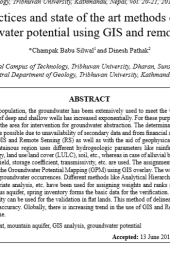Review on Practices and State of the Art Methods on Delineation of Ground Water Potential Using GIS and Remote Sensing
Summary
Global population growth has led to extensive groundwater usage for domestic and agricultural needs, resulting in a surge in deep and shallow well numbers. Delineating groundwater potential is crucial for sustainable abstraction. Integrating GIS, Remote Sensing (RS), and geophysical data offers an effective approach, especially when secondary data and financial resources are limited. In mountainous regions, parameters like rainfall, slope, elevation, etc., are considered, while alluvial basins focus on aquifer material, LULC, and hydrogeological factors. Groundwater Potential Mapping (GPM) using GIS overlay involves assigning weights and ranks to factors, often employing methods like AHP and expert knowledge. Validation methods include spring inventory in mountainous areas and aquifer characteristics in flat lands. This GIS and RS-based approach is globally embraced for accurate groundwater potential identification.
Categories:
Article
Publisher:
TU
Published Year:
2018
